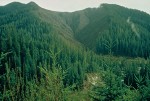LTER’s HydroDB Tool Facilitates Project
Part 1: The Study
Using a daily time-step over one- and five-year intervals, Julia Jones (Prof., Geosciences, OSU and Andrews LTER co-PI) is comparing streamflow response to forest removal at deciduous versus coniferous forest sites, as well as among sites with and without snowpacks.
This research breaks ground for ecohydrology because it gives a basis for linking climate controls to the ecophysiology of plants in the watershed, to streamflow, and to the effects of streamflow variability on aquatic ecosystems. Findings based on long-term records from Andrews, Coweeta, and Hubbard Brook sites (as well as Caspar Creek, Coyote Creek, and Fernow Experimental Forests) indicate that conversion of older forests to young forests can create persistent changes in snow accumulation and melt, affecting spring runoff, as well as summer streamflow deficits 10-25 years after forest conversion, potentially influencing stream habitat and biogeochemistry.
A paper describing this research has been accepted for publication in Water Resources Research, an interdisciplinary journal integrating research in the social and natural sciences.
Part II: Using HydroDB
The HydroDB tool was “extremely easy” to use for this study, Jones says. “It would be good for additional sites to add their data, particularly those spanning a wider range of climate and vegetation types (currently most sites in the HydroDB are forested).
A number of LTER sites have interesting, albeit shorter, hydro records from places with alpine, coastal/estuarine, desert, grassland, or other ecosystem types.”
HydroDB is a powerful tool, and there are many questions that could be investigated beyond what Jones and Post (in press) looked at. “Many of these were discussed at the ecohydrology workshop at the LTER ASM last fall [ASM Sept 2003],” Jones says.
“There’s lots of potential for a network of LTER sites to make a major contribution to the emerging discipline of eco-hydrology through the use, and augmentation of, HydroDB.” As well, many sites are already involved in related studies that are good candidates for integration, including:
- Forest ecosystems–Barbara Bond (AND)
- Emery Boose/Betsy Colburn (HFR)
- Bruce Haines/Alan Yeakley (CWT)
- Alan Covich/Todd Crouse (LUQ)
- Coastal ecosystems–Nat Weston (GCE)
- Sherry Mitchell-Bruker (FCE)
- Jen Wu Stanhope (VCR)
- Alpine/ tundra ecosystems–Tyler Erickson (NWT)
- Jay Jones (BNZ)
- Desert/grassland ecosystems– Cliff Dahm (SEV)
- Keith Gido (KNZ)
- Deb Peters/Nathan Hayes (JRN)
For more information, contact these investigors, who all participated in the ASM workshop, regarding what questions they are asking, and what future questions we could address as a network of LTER sites looking at ecohydrology.
In addition, Jones adds, HydroDB could be expanded to address much broader issues, well beyond the LTER Network, for example: How informatics is revolutionizing ecosystem studies, as manifested by activities at NCEAS, Bill Michener’s SEEK project (see LTER Network News Fall 2003), and the recently funded IGERT in Ecosystem Informatics at OSU (Julia Jones, PI, Mark Harmon, co-PI) “which will provide interdisciplinary graduate education in Ecosystem Informatics,” Jones says. For more information on the IGERT program for graduate student funding, please see the Oregon State University Web site.
A tool such as HydroDB also could help a national (or international) network of observatories to identify and address key questions in ecosystem science. “This relates to what I understand to be the AIBS recommendation for the structure and function of NEON,” Jones says.
For more information on HydroDB, see LTER Network News, Fall 2003.

 Enlarge this image
Enlarge this image
